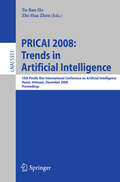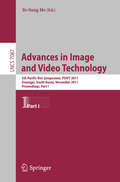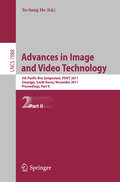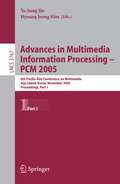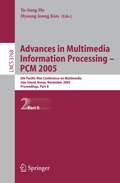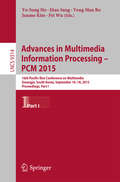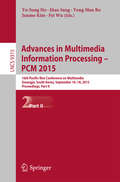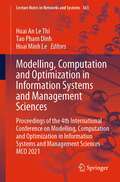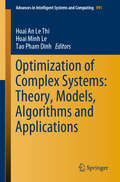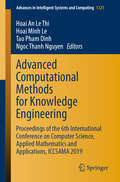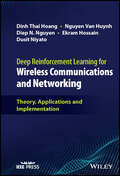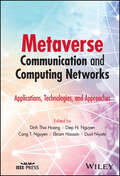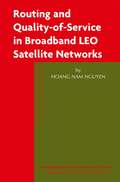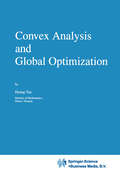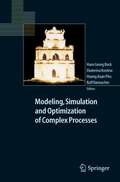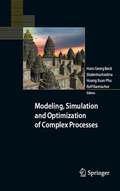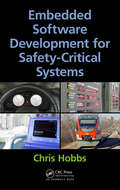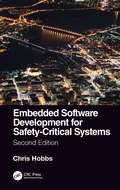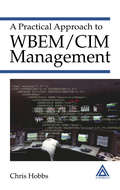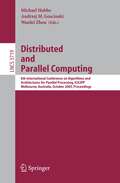- Table View
- List View
PRICAI 2008: 10th Pacific Rim International Conference on Artificial Intelligence, Hanoi, Vietnam, December 15-19, 2008, Proceedings (Lecture Notes in Computer Science #5351)
by Tu-Bao Ho Zhi-Hua ZhouThe Pacific Rim International Conference on Artificial Intelligence (PRICAI) is one of the preeminent international conferences on artificial intelligence (AI). PRICAI 2008 (http://www.jaist.ac.jp/PRICAI-08/) was the tenth in this series of biennial int- national conferences highlighting the most significant contributions to the field of AI. The conference was held during December 15–19, 2008, in the beautiful city Hanoi, the capital of Vietnam. As in previous years this year’s technical program saw very high standards in both the submission and paper review process, resulting in an exciting program that reflects the great variety and depth of modern AI research. This year’s contributions covered all traditional areas of AI, including AI foundations, knowledge representation, knowledge acquisition and ontologies, evolutionary computation, etc., as well as va- ous exciting and innovative applications of AI to many different areas. There was particular emphasis in the areas of machine learning and data mining, intelligent agents, language and speech processing, information retrieval and extraction.
Advances in Image and Video Technology: 5th Pacific Rim Symposium, PSIVT 2011, Gwangju, South Korea, November 20-23, 2011, Proceedings, Part I (Lecture Notes in Computer Science #7087)
by Yo-Sung HoThe two-volume proceedings LNCS 7087 + LNCS 7088 constitute the proceedings of the 5th Pacific Rim Symposium on Image and Video Technology, PSIVT 2011, held in Gwangju, Korea, in November 2011. The total of 71 revised papers was carefully reviewed and selected from 168 submissions. The topics covered are: image/video coding and transmission; image/video processing and analysis; imaging and graphics hardware and visualization; image/video retrieval and scene understanding; biomedical image processing and analysis; biometrics and image forensics; and computer vision applications.
Advances in Image and Video Technology: 5th Pacific Rim Symposium, PSIVT 2011, Gwangju, South Korea, November 20-23, 2011, Proceedings, Part II (Lecture Notes in Computer Science #7088)
by Yo-Sung HoThe two-volume proceedings LNCS 7087 + 7088 constitute the proceedings of the 5th Pacific Rim Symposium, PSIVT 2011, held in Gwangju, Korea, in November 2011. The total of 71 revised papers was carefully reviewed and selected from 168 submissions. The topics covered are: image/video coding and transmission; image/video processing and analysis; imaging and graphics hardware and visualization; image/video retrieval and scene understanding; biomedical image processing and analysis; biometrics and image forensics; and computer vision applications.
Advances in Multimedia Information Processing - PCM 2005: 6th Pacific Rim Conference on Multimedia, Jeju Island, Korea, November 11-13, 2005, Proceedings, Part I (Lecture Notes in Computer Science #3767)
by Yo-Sung Ho Hyoung Joong KimWe are delighted to welcome readers to the proceedings of the 6th Pacific-Rim Conference on Multimedia (PCM). The first PCM was held in Sydney, Australia, in 2000. Since then, it has been hosted successfully by Beijing, China, in 2001, Hsinchu, Taiwan, in 2002, Singapore in 2003, and Tokyo, Japan, in 2004, and finally Jeju, one of the most beautiful and fantastic islands in Korea. This year, we accepted 181 papers out of 570 submissions including regular and special session papers. The acceptance rate of 32% indicates our commitment to ensuring a very high-quality conference. This would not be possible without the full support of the excellent Technical Committee and anonymous reviewers that provided timely and insightful reviews. We would therefore like to thank the Program Committee and all reviewers. The program of this year reflects the current interests of the PCM’s. The accepted papers cover a range of topics, including, all aspects of multimedia, both technical and artistic perspectives and both theoretical and practical issues. The PCM 2005 program covers tutorial sessions and plenary lectures as well as regular presentations in three tracks of oral sessions and a poster session in a single track. We have tried to expand the scope of PCM to the artistic papers which need not to be strictly technical.
Advances in Multimedia Information Processing - PCM 2005: 6th Pacific Rim Conference on Multimedia, Jeju Island, Korea, November 11-13, 2005, Proceedings, Part II (Lecture Notes in Computer Science #3768)
by Yo-Sung Ho Hyoung-Joong KimWe are delighted to welcome readers to the proceedings of the 6th Pacific-Rim Conference on Multimedia (PCM). The first PCM was held in Sydney, Australia, in 2000. Since then, it has been hosted successfully by Beijing, China, in 2001, Hsinchu, Taiwan, in 2002, Singapore in 2003, and Tokyo, Japan, in 2004, and finally Jeju, one of the most beautiful and fantastic islands in Korea. This year, we accepted 181 papers out of 570 submissions including regular and special session papers. The acceptance rate of 32% indicates our commitment to ensuring a very high-quality conference. This would not be possible without the full support of the excellent Technical Committee and anonymous reviewers that provided timely and insightful reviews. We would therefore like to thank the Program Committee and all reviewers. The program of this year reflects the current interests of the PCM’s. The accepted papers cover a range of topics, including, all aspects of multimedia, both technical and artistic perspectives and both theoretical and practical issues. The PCM 2005 program covers tutorial sessions and plenary lectures as well as regular presentations in three tracks of oral sessions and a poster session in a single track. We have tried to expand the scope of PCM to the artistic papers which need not to be strictly technical.
Advances in Multimedia Information Processing -- PCM 2015: 16th Pacific-Rim Conference on Multimedia, Gwangju, South Korea, September 16-18, 2015, Proceedings, Part I (Lecture Notes in Computer Science #9314)
by Yo-Sung Ho Jitao Sang Yong Man Ro Junmo Kim Fei WuThe two-volume proceedings LNCS 9314 and 9315, constitute the proceedings of the 16th Pacific-Rim Conference on Multimedia, PCM 2015, held in Gwangju, South Korea, in September 2015. The total of 138 full and 32 short papers presented in these proceedings was carefully reviewed and selected from 224 submissions. The papers were organized in topical sections named: image and audio processing; multimedia content analysis; multimedia applications and services; video coding and processing; multimedia representation learning; visual understanding and recognition on big data; coding and reconstruction of multimedia data with spatial-temporal information; 3D image/video processing and applications; video/image quality assessment and processing; social media computing; human action recognition in social robotics and video surveillance; recent advances in image/video processing; new media representation and transmission technologies for emerging UHD services.
Advances in Multimedia Information Processing -- PCM 2015: 16th Pacific-Rim Conference on Multimedia, Gwangju, South Korea, September 16-18, 2015, Proceedings, Part II (Lecture Notes in Computer Science #9315)
by Yo-Sung Ho Jitao Sang Yong Man Ro Junmo Kim Fei WuThe two-volume proceedings LNCS 9314 and 9315, constitute the proceedings of the 16th Pacific-Rim Conference on Multimedia, PCM 2015, held in Gwangju, South Korea, in September 2015. The total of 138 full and 32 short papers presented in these proceedings was carefully reviewed and selected from 224 submissions. The papers were organized in topical sections named: image and audio processing; multimedia content analysis; multimedia applications and services; video coding and processing; multimedia representation learning; visual understanding and recognition on big data; coding and reconstruction of multimedia data with spatial-temporal information; 3D image/video processing and applications; video/image quality assessment and processing; social media computing; human action recognition in social robotics and video surveillance; recent advances in image/video processing; new media representation and transmission technologies for emerging UHD services.
Modelling, Computation and Optimization in Information Systems and Management Sciences: Proceedings of the 4th International Conference on Modelling, Computation and Optimization in Information Systems and Management Sciences - MCO 2021 (Lecture Notes in Networks and Systems #363)
by Hoai An Le Thi Tao Pham Dinh Hoai Minh LeThe proceedings consist of 34 papers which have been submitted to the 4th international conference on Modelling, Computation & Optimization in Information Systems and Management Science (MCO 2021) held on 11-13 December, 2021 at Hanoi, Vietnam. The book is composed of 3 parts: Optimization of complex systems - models and methods, Machine Learning - algorithms and applications, and Cryptography. All chapters in the books discuss theoretical and algorithmic as well as practical issues connected with modelling, computation & optimization in Information Systems and Management Science. Researchers and practitioners in related areas will find a wealth of inspiring ideas and useful tools & techniques for their own work.
Optimization of Complex Systems: Theory, Models, Algorithms and Applications (Advances in Intelligent Systems and Computing #991)
by Hoai An Le Thi Hoai Minh Le Tao Pham DinhThis book contains 112 papers selected from about 250 submissions to the 6th World Congress on Global Optimization (WCGO 2019) which takes place on July 8–10, 2019 at University of Lorraine, Metz, France. The book covers both theoretical and algorithmic aspects of Nonconvex Optimization, as well as its applications to modeling and solving decision problems in various domains. It is composed of 10 parts, each of them deals with either the theory and/or methods in a branch of optimization such as Continuous optimization, DC Programming and DCA, Discrete optimization & Network optimization, Multiobjective programming, Optimization under uncertainty, or models and optimization methods in a specific application area including Data science, Economics & Finance, Energy & Water management, Engineering systems, Transportation, Logistics, Resource allocation & Production management. The researchers and practitioners working in Nonconvex Optimization and several application areas can find here many inspiring ideas and useful tools & techniques for their works.
Advanced Computational Methods for Knowledge Engineering: Proceedings of the 6th International Conference on Computer Science, Applied Mathematics and Applications, ICCSAMA 2019 (Advances in Intelligent Systems and Computing #1121)
by Hoai An Le Thi Hoai Minh Le Tao Pham Dinh Ngoc Thanh NguyenThis proceedings book contains 37 papers selected from the submissions to the 6th International Conference on Computer Science, Applied Mathematics and Applications (ICCSAMA 2019), which was held on 19–20 December, 2019, in Hanoi, Vietnam. The book covers theoretical and algorithmic as well as practical issues connected with several domains of Applied Mathematics and Computer Science, especially Optimization and Data Science. The content is divided into four major sections: Nonconvex Optimization, DC Programming & DCA, and Applications; Data Mining and Data Processing; Machine Learning Methods and Applications; and Knowledge Information and Engineering Systems. Researchers and practitioners in related areas will find a wealth of inspiring ideas and useful tools & techniques for their own work.
Deep Reinforcement Learning for Wireless Communications and Networking: Theory, Applications and Implementation
by Dinh Thai Hoang Nguyen Van Huynh Diep N. Nguyen Ekram Hossain Dusit NiyatoDeep Reinforcement Learning for Wireless Communications and Networking Comprehensive guide to Deep Reinforcement Learning (DRL) as applied to wireless communication systems Deep Reinforcement Learning for Wireless Communications and Networking presents an overview of the development of DRL while providing fundamental knowledge about theories, formulation, design, learning models, algorithms and implementation of DRL together with a particular case study to practice. The book also covers diverse applications of DRL to address various problems in wireless networks, such as caching, offloading, resource sharing, and security. The authors discuss open issues by introducing some advanced DRL approaches to address emerging issues in wireless communications and networking. Covering new advanced models of DRL, e.g., deep dueling architecture and generative adversarial networks, as well as emerging problems considered in wireless networks, e.g., ambient backscatter communication, intelligent reflecting surfaces and edge intelligence, this is the first comprehensive book studying applications of DRL for wireless networks that presents the state-of-the-art research in architecture, protocol, and application design. Deep Reinforcement Learning for Wireless Communications and Networking covers specific topics such as: Deep reinforcement learning models, covering deep learning, deep reinforcement learning, and models of deep reinforcement learning Physical layer applications covering signal detection, decoding, and beamforming, power and rate control, and physical-layer security Medium access control (MAC) layer applications, covering resource allocation, channel access, and user/cell association Network layer applications, covering traffic routing, network classification, and network slicing With comprehensive coverage of an exciting and noteworthy new technology, Deep Reinforcement Learning for Wireless Communications and Networking is an essential learning resource for researchers and communications engineers, along with developers and entrepreneurs in autonomous systems, who wish to harness this technology in practical applications.
Deep Reinforcement Learning for Wireless Communications and Networking: Theory, Applications and Implementation
by Dinh Thai Hoang Nguyen Van Huynh Diep N. Nguyen Ekram Hossain Dusit NiyatoDeep Reinforcement Learning for Wireless Communications and Networking Comprehensive guide to Deep Reinforcement Learning (DRL) as applied to wireless communication systems Deep Reinforcement Learning for Wireless Communications and Networking presents an overview of the development of DRL while providing fundamental knowledge about theories, formulation, design, learning models, algorithms and implementation of DRL together with a particular case study to practice. The book also covers diverse applications of DRL to address various problems in wireless networks, such as caching, offloading, resource sharing, and security. The authors discuss open issues by introducing some advanced DRL approaches to address emerging issues in wireless communications and networking. Covering new advanced models of DRL, e.g., deep dueling architecture and generative adversarial networks, as well as emerging problems considered in wireless networks, e.g., ambient backscatter communication, intelligent reflecting surfaces and edge intelligence, this is the first comprehensive book studying applications of DRL for wireless networks that presents the state-of-the-art research in architecture, protocol, and application design. Deep Reinforcement Learning for Wireless Communications and Networking covers specific topics such as: Deep reinforcement learning models, covering deep learning, deep reinforcement learning, and models of deep reinforcement learning Physical layer applications covering signal detection, decoding, and beamforming, power and rate control, and physical-layer security Medium access control (MAC) layer applications, covering resource allocation, channel access, and user/cell association Network layer applications, covering traffic routing, network classification, and network slicing With comprehensive coverage of an exciting and noteworthy new technology, Deep Reinforcement Learning for Wireless Communications and Networking is an essential learning resource for researchers and communications engineers, along with developers and entrepreneurs in autonomous systems, who wish to harness this technology in practical applications.
Metaverse Communication and Computing Networks: Applications, Technologies, and Approaches
by Dinh Thai Hoang Diep N. Nguyen Cong T. Nguyen Ekram Hossain Dusit NiyatoMetaverse Communication and Computing Networks Understand the future of the Internet with this wide-ranging analysis “Metaverse” is the term for applications that allow users to assume digital avatars to interact with other humans and software functions in a three-dimensional virtual space. These applications and the spaces they create constitute an exciting and challenging new frontier in digital communication. Surmounting the technological and conceptual barriers to creating the Metaverse will require researchers and engineers familiar with its underlying theories and a wide range of technologies and techniques. Metaverse Communication and Computing Networks provides a comprehensive treatment of Metaverse theory and the technologies that can be brought to bear on this new pursuit. It begins by describing the Metaverse’s underlying architecture and infrastructure, physical and digital, before addressing how existing technologies are being adapted to its use. It concludes with an overview of the challenges facing the Metaverse. The result is a thorough introduction to a subject that may define the future of the internet. Metaverse Communication and Computing Networks readers will also find: Detailed treatment of technologies, including artificial intelligence, Virtual Reality, Extended Reality, and more Analysis of issues including data security, ethics, privacy, and social impact A real-world prototype for Metaverse applications Metaverse Communication and Computing Networks is a must-own for researchers and engineers looking to understand this growing area of technology, and entrepreneurs interested in establishing Metaverse businesses.
Metaverse Communication and Computing Networks: Applications, Technologies, and Approaches
by Dinh Thai Hoang Diep N. Nguyen Cong T. Nguyen Ekram Hossain Dusit NiyatoMetaverse Communication and Computing Networks Understand the future of the Internet with this wide-ranging analysis “Metaverse” is the term for applications that allow users to assume digital avatars to interact with other humans and software functions in a three-dimensional virtual space. These applications and the spaces they create constitute an exciting and challenging new frontier in digital communication. Surmounting the technological and conceptual barriers to creating the Metaverse will require researchers and engineers familiar with its underlying theories and a wide range of technologies and techniques. Metaverse Communication and Computing Networks provides a comprehensive treatment of Metaverse theory and the technologies that can be brought to bear on this new pursuit. It begins by describing the Metaverse’s underlying architecture and infrastructure, physical and digital, before addressing how existing technologies are being adapted to its use. It concludes with an overview of the challenges facing the Metaverse. The result is a thorough introduction to a subject that may define the future of the internet. Metaverse Communication and Computing Networks readers will also find: Detailed treatment of technologies, including artificial intelligence, Virtual Reality, Extended Reality, and more Analysis of issues including data security, ethics, privacy, and social impact A real-world prototype for Metaverse applications Metaverse Communication and Computing Networks is a must-own for researchers and engineers looking to understand this growing area of technology, and entrepreneurs interested in establishing Metaverse businesses.
Routing and Quality-of-Service in Broadband LEO Satellite Networks (Broadband Networks and Services #2)
by Hoang Nam NguyenRouting and Quality-of-Service in Broadband LEO Satellite Networks describes mechanisms for supporting Quality-of-Service (QoS) strategies that consider properties of low earth orbit satellite networks and their effects on link handover. A graph model representing the dynamic topology of a satellite constellation is introduced based on a new parameter, lifetime. Novel routing and resource reservation algorithms as well as connection admission control strategies are proposed to minimize the handover blocking probability while maintaining QoS requirements. The author also discusses the roles of satellites in an all-IP mobile network architecture and the problems of mobility, QoS provisioning, and routing. This work will be of particular interest to researchers and professionals working on mobility networking in next generation networks.
Convex Analysis and Global Optimization (Nonconvex Optimization and Its Applications #22)
by Hoang TuyDue to the general complementary convex structure underlying most nonconvex optimization problems encountered in applications, convex analysis plays an essential role in the development of global optimization methods. This book develops a coherent and rigorous theory of deterministic global optimization from this point of view. Part I constitutes an introduction to convex analysis, with an emphasis on concepts, properties and results particularly needed for global optimization, including those pertaining to the complementary convex structure. Part II presents the foundation and application of global search principles such as partitioning and cutting, outer and inner approximation, and decomposition to general global optimization problems and to problems with a low-rank nonconvex structure as well as quadratic problems. Much new material is offered, aside from a rigorous mathematical development. Audience: The book is written as a text for graduate students in engineering, mathematics, operations research, computer science and other disciplines dealing with optimization theory. It is also addressed to all scientists in various fields who are interested in mathematical optimization.
Modeling, Simulation and Optimization of Complex Processes: Proceedings of the International Conference on High Performance Scientific Computing, March 10-14, 2003, Hanoi, Vietnam
by Xuan Phu Hoang Rolf Rannacher Hans Georg Bock Ekaterina KostinaThis proceedings volume contains a selection of papers presented at the symposium "International Conference on High Performance Scientific Computing'' held at the Hanoi Institute of Mathematics of the Vietnam National Center for Natural Science and Technology (NCST), March 10-14, 2003. The conference has been organized by the Hanoi Institute of Mathematics, SFB 359 ''Reactive Flows, Transport and Diffusion'', Heidelberg, Ho Chi Minh City University of Technology and Interdisciplinary Center for Scientific Computing (IWR), Heidelberg. The contributions cover the broad interdisciplinary spectrum of scientific computing and present recent advances in theory, development of methods, and applications in practice. Subjects covered are mathematical modelling, numerical simulation, methods for optimization and optimal control, parallel computing, symbolic computing, software development, applications of scientific computing in physics, chemistry, biology and mechanics, environmental and hydrology problems, transport, logistics and site location, communication networks, production scheduling, industrial and commercial problems.
Modeling, Simulation and Optimization of Complex Processes: Proceedings of the Third International Conference on High Performance Scientific Computing, March 6-10, 2006, Hanoi, Vietnam
by Xuan Phu Hoang Rolf Rannacher Hans Georg Bock Ekaterina KostinaEmbedded Software Development for Safety-Critical Systems
by Chris HobbsSafety-critical devices, whether medical, automotive, or industrial, are increasingly dependent on the correct operation of sophisticated software. Many standards have appeared in the last decade on how such systems should be designed and built. Developers, who previously only had to know how to program devices for their industry, must now understand remarkably esoteric development practices and be prepared to justify their work to external auditors. Embedded Software Development for Safety-Critical Systems discusses the development of safety-critical systems under the following standards: IEC 61508; ISO 26262; EN 50128; and IEC 62304. It details the advantages and disadvantages of many architectural and design practices recommended in the standards, ranging from replication and diversification, through anomaly detection to the so-called "safety bag" systems.Reviewing the use of open-source components in safety-critical systems, this book has evolved from a course text used by QNX Software Systems for a training module on building embedded software for safety-critical devices, including medical devices, railway systems, industrial systems, and driver assistance devices in cars. Although the book describes open-source tools for the most part, it also provides enough information for you to seek out commercial vendors if that’s the route you decide to pursue. All of the techniques described in this book may be further explored through hundreds of learned articles. In order to provide you with a way in, the author supplies references he has found helpful as a working software developer. Most of these references are available to download for free.
Embedded Software Development for Safety-Critical Systems
by Chris HobbsSafety-critical devices, whether medical, automotive, or industrial, are increasingly dependent on the correct operation of sophisticated software. Many standards have appeared in the last decade on how such systems should be designed and built. Developers, who previously only had to know how to program devices for their industry, must now understand remarkably esoteric development practices and be prepared to justify their work to external auditors. Embedded Software Development for Safety-Critical Systems discusses the development of safety-critical systems under the following standards: IEC 61508; ISO 26262; EN 50128; and IEC 62304. It details the advantages and disadvantages of many architectural and design practices recommended in the standards, ranging from replication and diversification, through anomaly detection to the so-called "safety bag" systems.Reviewing the use of open-source components in safety-critical systems, this book has evolved from a course text used by QNX Software Systems for a training module on building embedded software for safety-critical devices, including medical devices, railway systems, industrial systems, and driver assistance devices in cars. Although the book describes open-source tools for the most part, it also provides enough information for you to seek out commercial vendors if that’s the route you decide to pursue. All of the techniques described in this book may be further explored through hundreds of learned articles. In order to provide you with a way in, the author supplies references he has found helpful as a working software developer. Most of these references are available to download for free.
Embedded Software Development for Safety-Critical Systems, Second Edition
by Chris HobbsThis is a book about the development of dependable, embedded software. It is for systems designers, implementers, and verifiers who are experienced in general embedded software development, but who are now facing the prospect of delivering a software-based system for a safety-critical application. It is aimed at those creating a product that must satisfy one or more of the international standards relating to safety-critical applications, including IEC 61508, ISO 26262, EN 50128, EN 50657, IEC 62304, or related standards. Of the first edition, Stephen Thomas, PE, Founder and Editor of FunctionalSafetyEngineer.com said, "I highly recommend Mr. Hobbs' book."
Embedded Software Development for Safety-Critical Systems, Second Edition
by Chris HobbsThis is a book about the development of dependable, embedded software. It is for systems designers, implementers, and verifiers who are experienced in general embedded software development, but who are now facing the prospect of delivering a software-based system for a safety-critical application. It is aimed at those creating a product that must satisfy one or more of the international standards relating to safety-critical applications, including IEC 61508, ISO 26262, EN 50128, EN 50657, IEC 62304, or related standards. Of the first edition, Stephen Thomas, PE, Founder and Editor of FunctionalSafetyEngineer.com said, "I highly recommend Mr. Hobbs' book."
A Practical Approach to WBEM/CIM Management
by Chris HobbsSystem architects and engineers in fields such as storage networking, desktop computing, electrical power distribution, and telecommunications need a common and flexible way of managing heterogeneous devices and services. Web-Based Enterprise Management (WBEM) and its Component Information Model (CIM) provide the architecture, language, interfaces,
A Practical Approach to WBEM/CIM Management
by Chris HobbsSystem architects and engineers in fields such as storage networking, desktop computing, electrical power distribution, and telecommunications need a common and flexible way of managing heterogeneous devices and services. Web-Based Enterprise Management (WBEM) and its Component Information Model (CIM) provide the architecture, language, interfaces,
Distributed and Parallel Computing: 6th International Conference on Algorithms and Architectures for Parallel Processing, ICA3PP, Melbourne, Australia, October 2-3, 2005, Proceedings (Lecture Notes in Computer Science #3719)
by Michael Hobbs Andrzej Goscinski Wanlei ZhouThere are many applications that require parallel and distributed processing to allow complicated engineering, business and research problems to be solved in a reasonable time. Parallel and distributed processing is able to improve company profit, lower costs of design, production, and deployment of new technologies, and create better business environments. The major lesson learned by car and aircraft engineers, drug manufacturers, genome researchers and other specialist is that a computer system is a very powerful tool that is able to help them solving even more complicated problems. That has led computing specialists to new computer system architecture and exploiting parallel computers, clusters of clusters, and distributed systems in the form of grids. There are also institutions that do not have so complicated problems but would like to improve profit, lower costs of design and production by using parallel and distributed processing on clusters. In general to achieve these goals, parallel and distributed processing must become the computing mainstream. This implies a need for new architectures of parallel and distributed systems, new system management facilities, and new application algorithms. This also implies a need for better understanding of grids and clusters, and in particular their operating systems, scheduling algorithms, load balancing, heterogeneity, transparency, application deployment, which is of the most critical importance for their development and taking them by industry and business.
